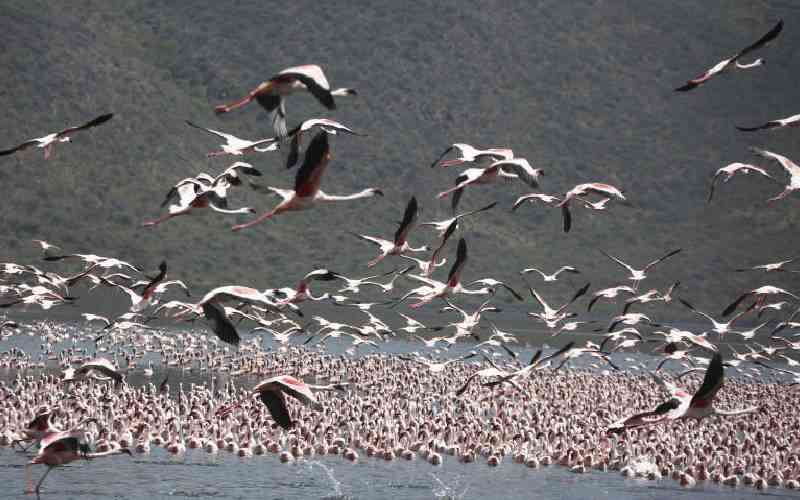Like other parts of the country, Tharaka-Nithi County has not been spared the brutal effects of climate change. It has led to unpredictable rainfall patterns, decrease in water volumes, low food production and prolonged drought that comes with outbreaks of new diseases.
Many farmers may not be familiar with the text book science behind climate change, but what they do know for sure, is that it is real and is affecting their lives.
They see it in the changing weather patterns, which is characterised by exceptionally dry weather and disastrous floods, which ultimately leads to poor crop and animal yields.
Brutal as climate change may be, farmers are learning to use creative means to cope with this harsh reality.
Purity Gatiria, a 44-year-old farmer from South Tharaka in Tharaka-Nithi County has devised smart ways to cope in her ten acre farm.
Strategic resources
She has partitioned her farm into small manageable acres with green grams, millet, bananas, oranges and pawpaw and on a good season, she takes home Sh300,000.
And her secret?
“I employ minimal tilling on the farm. For weeding, I avoid using farm equipments like pangas and jembes and instead use my hands to uproot the weeds, which I later use for mulching. This helps with moisture conservation,” she explains.
Upon harvest, she uses pesticides to do away with the weeds and only uses the farm equipment to dig the holes. She also plants early before the rainy season.
“I also look for fast growing and early maturing variety of crops,” she explains.
Gatiria also rears upgraded livestock that are adapted to the environment. She uses the cow dung as manure.
“Farmers should not sell the little manure they get from their livestock but instead use it for farming to better their yields,” she advices.
She further urges farmers to turn away from the traditional forms of farming and embrace the new technologies for better yields.
The interesting thing about Tharaka-Nithi is that despite the fact that it is located near Mount Kenya meaning it should have favourable weather, it has been hit hard by climate change.
Stay informed. Subscribe to our newsletter
A natural resource management expert Jafford Njeru concurs.
“This is very true. Because of this, the county cannot produce sufficient food to feed its own people. As we speak, 70 per cent of the land is on arid and semi-arid land with less than 30 per cent of it being used for arable farming,” he says.
But why the brutal effect in a county that is so close to a strategic mountain?
Strategies for Agropatrolists Development (Sapad) CEO Chabari Kiura, sheds light, “Effects of climate change in Tharaka-Nithi County is a great concern given the fact that it has affected food production.” Sapad is an NGO that deals with climate change, food security, and soil and water management.
Kiura notes that climate change problem is aggravated by deforestation, which is linked to corruption.
“Cutting down of trees has seen both the indigenous and exotic trees get extinct. Some corrupt county officials issue permits for logging illegally to individuals,” Kiura explains.
And what compounds the problem further is the fact that some farmers are reluctant to adapt to the new methods of farming that do not worsen the problem.
Agriculture, Livestock Fisheries and Irrigation CEO Walter Mugambi concurs with this saying: “Most farmers ignore best practice tips given to them by experts. For instance, some still adamantly plant maize and beans despite numerous trainings by the county government that the soil is not suitable for these crops.”
Bethuel Wafula the County Drought Co-ordinator, observes that many farmers continue to keep herds of cattle that die during drought, with many of them still depending on their farms on wet lands and along the river banks. This in turn leads to drying of some rivers. For example, River Thanantu and River Thingitu in Tharaka Constituency have been affected by human encroachment.”
The county government is working on ways to improve the situation like promoting drought-tolerant early maturing crops like pigeon peas, green grams, sorghum cow peas.
“The county government is doing everything to address the issue. But a legal framework to govern the same is lacking, a factor that negates the implementation and enforcement,” says Wafula.
The future
To address this problem, experts say afforestation programmes need to be embraced to avoid future calamities. At the same time, Kiura discourages the use of certified seedlings saying, “They are not the solution.”
Instead, farmers should use indigenous seeds like green grams, millet, cassava and pigeon peas among others, “As they are adapted to the environment,” he says.
Kiura also cites the need to come up with activities that increase forest cover like planting trees, rehabilitation of river banks, hill tops and promotion of agro-forestry.
David Mugambi, a natural resources management and climate change co-ordinator advices: “Farmers should embrace new technologies, which factor in environment conservation. They cannot use yesteryears’ methods in today’s world and expect to survive tomorrow.”
 The Standard Group Plc is a
multi-media organization with investments in media platforms spanning newspaper
print operations, television, radio broadcasting, digital and online services. The
Standard Group is recognized as a leading multi-media house in Kenya with a key
influence in matters of national and international interest.
The Standard Group Plc is a
multi-media organization with investments in media platforms spanning newspaper
print operations, television, radio broadcasting, digital and online services. The
Standard Group is recognized as a leading multi-media house in Kenya with a key
influence in matters of national and international interest.
 The Standard Group Plc is a
multi-media organization with investments in media platforms spanning newspaper
print operations, television, radio broadcasting, digital and online services. The
Standard Group is recognized as a leading multi-media house in Kenya with a key
influence in matters of national and international interest.
The Standard Group Plc is a
multi-media organization with investments in media platforms spanning newspaper
print operations, television, radio broadcasting, digital and online services. The
Standard Group is recognized as a leading multi-media house in Kenya with a key
influence in matters of national and international interest.








